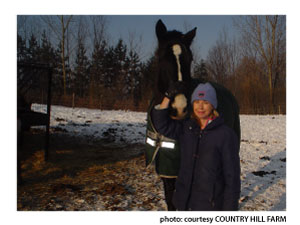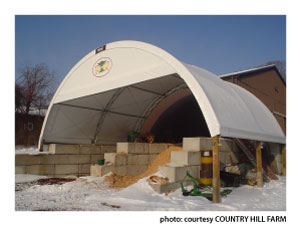ARCHIVE EQUINE NEWS STORIES
| Current news is available at TheHorsePortal.ca, Equine Guelph's online learning platform for practical, quick learning. Given the vast amount of information on horse health and welfare, Equine Guelph has archived its past news articles from 2002-2020. They are listed below, along with a search function available to find specific healthcare topics. | |
Just Add Horses: A Manure Success StoryNovember 2010
by Mat MacLean
 This past January, I had a chance to visit Kathy Fremes, owner and manager of Country Hill Farm in Stouffville. I went to see the environmental beneficial management practices (BMPs) that she has implemented on her farm. Located 45 minutes northeast of Toronto and situated on 30 acres of the Oak Ridges Moraine, Country Hill Farm is home to 25 horses and includes a large indoor arena, outdoor sand ring, a grass dressage ring, a stadium jumper course, a cross-country course, and 19 box stalls, including a foaling and wash stall. Oh yes, the facility is impressive, but what was really impressive was the manure composting methods used at Country Hill Farm.
This past January, I had a chance to visit Kathy Fremes, owner and manager of Country Hill Farm in Stouffville. I went to see the environmental beneficial management practices (BMPs) that she has implemented on her farm. Located 45 minutes northeast of Toronto and situated on 30 acres of the Oak Ridges Moraine, Country Hill Farm is home to 25 horses and includes a large indoor arena, outdoor sand ring, a grass dressage ring, a stadium jumper course, a cross-country course, and 19 box stalls, including a foaling and wash stall. Oh yes, the facility is impressive, but what was really impressive was the manure composting methods used at Country Hill Farm.
Fremes, who has been involved with the equine industry from an early age, has a passion not only for horses, but also for the environment. In between the duties of managing her facility, coaching students, and training horses, Fremes sits on the executive as the Secretary for the Ontario Equestrian Federation, and chairs its Horse Facilities Advisory Council. Her passion for the environment is evident when you look beyond the stable doors and see how the waste is managed on site. “My farm received the ‘Just Add Horses’ Environment Award, but I still want to further reduce my carbon hoof print and there is grant money out there to help us to achieve that goal, such as the Environmental Farm Plan” says Fremes. Kathy is modest in acknowledging the award that is presented to the horse facility owner who has demonstrated an active approach to conserving the environment.
Waste, such as manure and stall residue, can be a problem on horse farms. Generally not dense enough in nutrients to be a high value fertilizer, many facilities have to pay to have manure and soiled bedding removed from their operations. At Country Hill Farm, this waste is turned into a nutrient rich natural fertilizer through composting. The natural process of composting decomposes organic matter, shrinking the volume and maintaining the amount of nutrients making it more nutrient dense. At Country Hill Farm, the composted waste is used to grow hay on a nearby field, top dress summer paddocks, and enrich the soil in extensive vegetable and flower gardens. This compost was also used for planting hundreds of trees and shrubs to reduce the erosion on the farm and act as wind breaks.
Here is Kathy’s successful recipe from horse to hay. First, to reduce the amount of bedding material needed and still provide comfort for the horses stabled indoors at night, Fremes lines each stall with rubber mats. In addition, she does not use all of her 19 stalls as many of her herd live out of doors 24/7. The manure from the paddocks, mixed with the waste hay, is also composted and is used for the same purposes as the indoor material. The waste material collected from mucking out the stables is deposited into one of two stalls in a covered storage area where the composting begins. Here it will be left to decompose for about 6 months being turned over periodically to give oxygen to the busy microbes working throughout the pile. When it is sufficiently decomposed and resembles nutrient rich soil, the compost is hauled away to be spread on a nearby field used to grow hay.
 Careful storage and handling of manure is key to protecting the environment. Kathy’s storage area is a shining example of how to store solid manure. Kathy has an impermeable concrete pad with 2 U shaped stalls of large interlocking concrete blocks—each of which are 6 feet long by 3 feet wide and 2 feet high. A total of 90 blocks were used to complete this structure which also acts as a retaining wall for the extension of Fremes’ arena. “We had to create a retaining wall anyhow so I thought if we were going to all this expense we might as well do the manure storage,” says Fremes adding “it was a lucky guess that I managed to build it larger than we actually needed because we did not have a Nutrient Management Strategy (NMS) at that time. I would advise anyone embarking on such a project to build bigger than your actual present day needs to accommodate future expansion of your business and therefore needs.”
Careful storage and handling of manure is key to protecting the environment. Kathy’s storage area is a shining example of how to store solid manure. Kathy has an impermeable concrete pad with 2 U shaped stalls of large interlocking concrete blocks—each of which are 6 feet long by 3 feet wide and 2 feet high. A total of 90 blocks were used to complete this structure which also acts as a retaining wall for the extension of Fremes’ arena. “We had to create a retaining wall anyhow so I thought if we were going to all this expense we might as well do the manure storage,” says Fremes adding “it was a lucky guess that I managed to build it larger than we actually needed because we did not have a Nutrient Management Strategy (NMS) at that time. I would advise anyone embarking on such a project to build bigger than your actual present day needs to accommodate future expansion of your business and therefore needs.”
The manure storage is covered and sheltered from precipitation. Each storage stall is roughly 35 feet long by 18 feet wide and 8 feet deep and actually can contain more than a full year’s of manure if both are used. “If we don’t need both bins for manure then we can store bulk shavings that we use for bedding in the empty one,” said Fremes.
By covering the solid manure storage, Fremes has taken a step towards preventing water contamination. This is a positive outcome, which is even more valuable considering the farm’s location on the Oak Ridges Moraine, a source of much of Southern Ontario’s drinking water. Uncovered manure piles are exposed to precipitation and in some cases topography and nearby buildings can affect wind currents resulting in more precipitation landing on these piles. For example, snow will accumulate on the lee side of a building and if a manure pile is there, that extra accumulation can lead to increased runoff. Rain, snow, or any other type of precipitation will eventually runoff the manure pile and into nearby surface water or seep into the ground. As the water flows off the manure it takes bacteria and nutrients with it. The bacteria can create human and animal health problems, and the nutrients can contaminate groundwater making it unsafe to drink. In surface water, excess nutrients create algae blooms which put considerable stress on aquatic species by lowering dissolved oxygen levels. The $12,000 fabric roof over this solid manure storage almost eliminates the problem of manure pile runoff all together and was almost entirely funded with government grants.
Fremes has taken it upon herself to be a good steward of her land which means taking responsible action to effectively manage the environmental aspects of her business. Because of all the options available that can make a difference to the environment, like preserving water quality and implementing beneficial management practices (BMPs) such as composting manure, there are always opportunities to become a better steward of your land. With so many improvements to choose from, there is usually at least one available for any environmental issue you are faced with. For more information on Country Hill Farm, check out www.countryhillfarm.ca.
To find out more about stewardship programs available to help you improve the natural buffers around water features on your land, contact your local Conservation Authority. Not sure which of the 36 Conservation Authorities you should contact, check out the provincial map and contact listing on the Conservation Ontario website at www.Conservation-Ontario.on.ca.
This article has been prepared by the Healthy Lands for Healthy Horses Steering Committee, which is comprised of representatives from the Horse Facilities Council, Uxbridge Horseman’s Association, Ontario Trail Riders Association, Equine Guelph, University of Guelph, Ontario Ministry of Agriculture, Food and Rural Affairs, Ontario Equestrian Federation and various Conservation Authorities. Funding for events organized by this committee has been provided by the Ontario Soil and Crop Improvement Association from the Nutrient Management BMP Demonstration Grant funding project.
For more information please visit: www.equineguelph.ca/healthylands.php
Sidebars:
1. Nutrient management plans (NMP) and nutrient management strategies (NMS) can help you determine how much manure your horses generate and how it is stored and used. You can hire a professional to prepare one for you or you can take a course and do it yourself. Country Hill Farm has a nutrient management strategy as well as an Environmental Farm Plan. Visit www.omafra.gov.on.ca/english/agops/index.html for more information on Nutrient Management, and visit www.ontariosoilcrop.org or www.omafra.gov.on.ca/english/environment/efp/efp.htm for more information on Environmental Farm Plans.
2. There is an excellent series of award winning books with information for improving your farm’s environmental performance; the Best Management Practices Series of books produced by Agriculture and Agri-Food Canada and the Ontario Ministry of Agriculture, Food, and Rural Affairs. You can find and order these books for no charge by visiting www.publications.serviceontario.ca/ecom/ and typing “BMP” in the search box.
3. If you want more information on implementing BMPs at your property and to find out if you qualify for funding for such projects contact your local conservation authority. You can find your conservation authority at www.conservation-ontario.on.ca/find/index.html.